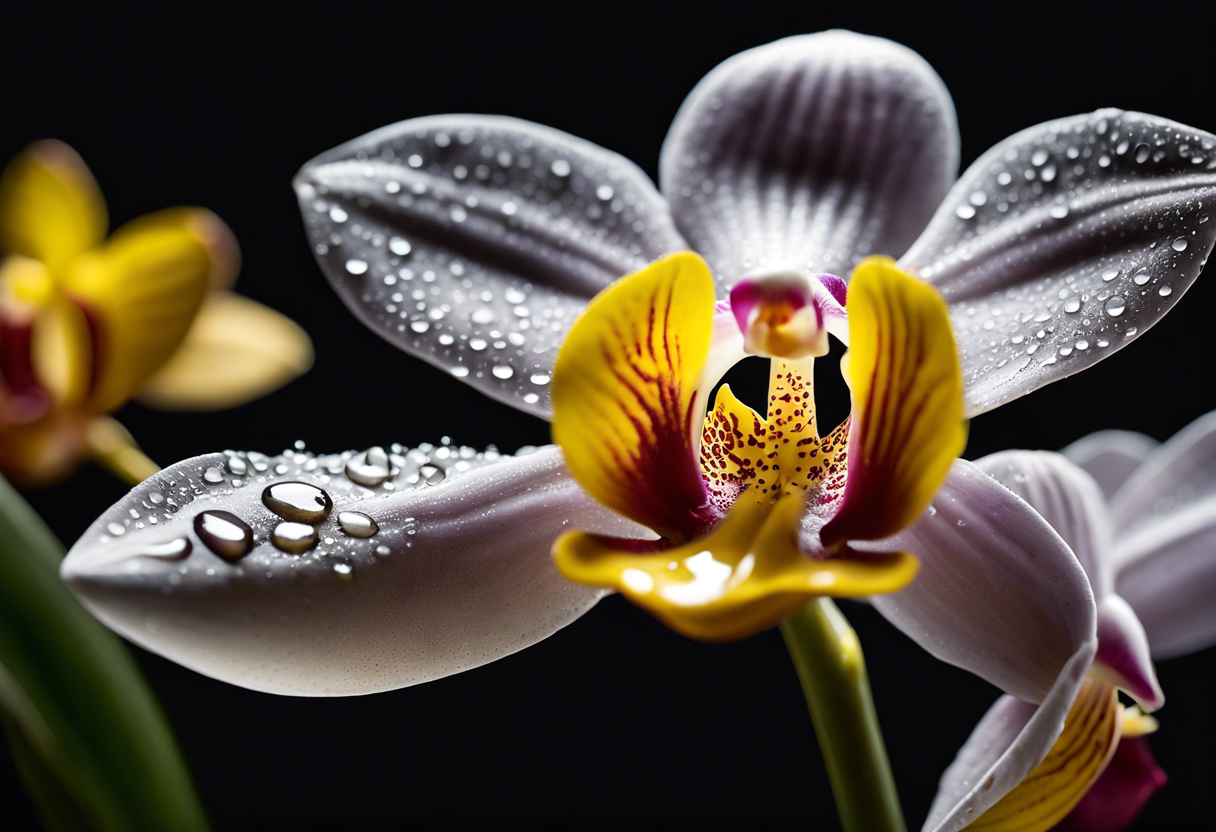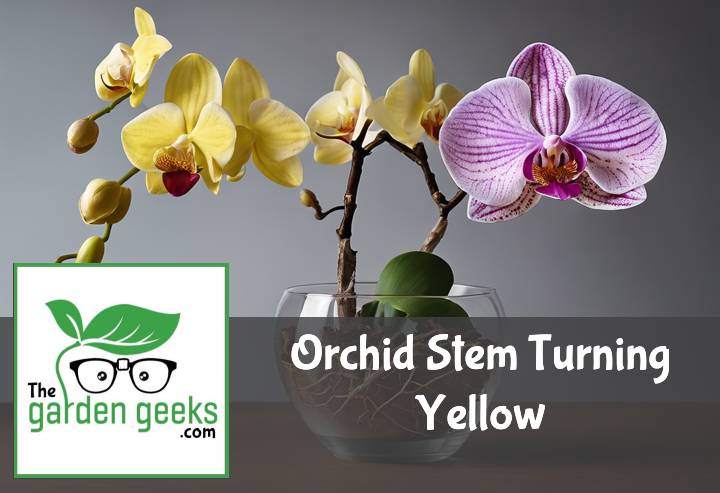Have you ever looked at your beloved orchid only to notice the stem turning yellow? If so, you might have thought, “Oh no! My Orchid Stem Turning Yellow. What did I do wrong?” Don’t fret! It’s not necessarily a death sentence for your green-thumb reputation.
In fact, it could be due to a variety of reasons such as overwatering, insufficient light or nutrient deficiency. But before we dive deep into these causes, let’s take a moment to understand that plants, like us humans, have their own quirks and unique ways of communicating distress. So buckle up, plant parent! We’re about to decode some botanical lingo here. Keep reading about ‘Orchid Stem Turning Yellow? (3 Reasons)’.
Key Takeaways
- An orchid stem can turn yellow due to overwatering, which leads to root rot and prevents the plant from absorbing nutrients.
- Exposure to extreme temperatures or direct sunlight can also cause the stem to yellow, as orchids prefer moderate conditions.
- Nutrient deficiency, particularly lack of nitrogen, can result in a yellow stem. Regular feeding with a balanced orchid fertilizer can help address this issue.

Why is My Orchid Stem Turning Yellow?
Ever wondered why your Orchid Stem Turning Yellow? It could be due to its natural lifecycle or signs of stress. Understanding orchid care can help you decipher the mystery behind a yellowing orchid stem.
Understanding the Natural Lifecycle of an Orchid
Orchids, like any other plant, have a lifecycle. During certain stages, especially as they age, it’s not uncommon for an orchid’s stem to turn yellow. This is part of the orchid lifecycle stages, and it’s completely normal.
The blooming cycle of orchids also plays a role in this color change. After blooming, orchids go through a rest period where leaves may yellow and drop off. So if your aging orchids are showing some yellow, don’t panic!
Recognizing Signs of Stress in Orchids
On the flip side, if your healthy orchid suddenly starts turning yellow, it might be under stress. The key is recognizing these orchid stress symptoms early on.
Overwatering or underwatering can cause significant stress leading to a yellow stem. If you’ve been heavy-handed with the watering can or neglectful, your orchid might be telling you something.
Temperature fluctuations too can cause stress in these tropical beauties. If your home resembles a sauna one day and an icebox the next, don’t be surprised if your orchid throws a little color-changing tantrum!
Reason 1: Overwatering

Overwatering is a common culprit when it comes to an orchid stem turning yellow. It’s a classic case of too much love, folks! But don’t worry, we’re here to help you navigate the waters of orchid care.
How Overwatering Affects Orchid Stems
When you overwater your orchids, the stems can become waterlogged. This isn’t a spa day for them; it’s more like being stuck in a rainstorm without an umbrella! The excess water causes the cells in the stem to swell and eventually burst, leading to damage. This is why your orchid stem might be looking more mellow yellow than vibrant green.
The damage from overwatering doesn’t stop there. As the water continues to sit around the roots, it creates a perfect environment for root rot. And trust me, root rot is as nasty as it sounds! It can lead to further signs of overwatering in plants, including that dreaded yellow hue on your orchid stems.
Identifying Overwatering Symptoms in Orchids
So how do you know if your orchid has been hitting the water bottle too hard? Well, aside from the obvious orchid stem turning yellow, there are other signs you can look out for.
Firstly, check out those leaves. If they’re looking limp and lifeless or have black spots, that could be a sign of overwatering. Also, take a peek at the roots. Healthy roots should be firm and white or greenish in color. If they’re brown and mushy – Houston, we have an overwatering problem!
Remember folks; diagnosing plant water issues isn’t always straightforward. Sometimes these symptoms can also indicate under-watering or other health issues. So keep an eye on your orchids and learn their likes and dislikes.
Corrective Measures for Overwatered Orchids
If you’ve diagnosed your orchid with a case of overwatering, don’t panic! There are steps you can take to nurse it back to health and prevent future water damage.
First things first, stop watering immediately. Let the plant dry out completely before giving it any more H2O. You might also want to repot the orchid in fresh, well-draining soil to help get rid of any excess moisture.
In severe cases, you may need to trim away any rotten roots or stems. It’s like a haircut for your plant – sometimes a little off the top is just what it needs! And remember, when it comes to watering orchids, less is often more. So next time, go easy on the agua!

Reason 2: Insufficient Light
When it comes to orchid care, light plays a crucial role. If your orchid stem turning yellow, it might be crying out for more light.
The Role of Light in Orchid Health
Light is like the breakfast of champions for orchids. It’s essential for photosynthesis, which is how plants make their food. Without enough light, your orchid could end up on a diet it didn’t sign up for!
Now, sunlight needs for orchids aren’t as high as you might think. They’re not sun-worshipers like tomatoes or roses. But they still need their fair share to stay healthy and vibrant.
Signs Your Orchid Isn’t Getting Enough Light
So how do you know if your orchid is throwing shade at you? Well, if the leaves are turning yellow or the growth seems stunted, that’s a pretty clear sign.
Remember, we’re talking about the orchid stem turning yellow, not a golden tan! If your plant looks more like a banana than an orchid, it’s probably time to rethink your lighting situation.
Adjusting Light Conditions for Your Orchid
Alright, so what can you do about this? First off, don’t panic! There are plenty of indoor plant lighting solutions available these days. You can increase sunlight exposure by moving your plant closer to a window or even invest in some grow lights.
Just remember – when it comes to adjusting light for orchids, it’s all about balance. Too much light can be just as harmful as too little. So take baby steps and keep an eye on your plant until it starts looking happier and healthier again.
Reason 3: Nutrient Deficiency
If your Orchid Stem Turning Yellow, it might be crying out for some essential nutrients. Just like us humans, orchids need a balanced diet to stay healthy.
Essential Nutrients for Orchids
Orchids are pretty low-maintenance, but they do have some dietary needs. They crave essential plant nutrients like nitrogen, phosphorus, and potassium. Nitrogen is the lifeblood of plants; it’s crucial for their growth and development.
Phosphorus plays a key role in energy transfer and storage. It’s the battery pack of the plant world! And then there’s potassium, which is like the orchid’s personal trainer. It strengthens the plant and helps it fight off diseases.
Detecting Nutrient Deficiency in Orchids
Now that we know what our green friends need, how can we tell if they’re lacking something? Well, signs of plant nutrient deficiency aren’t always as obvious as a yellow orchid stem.
Your orchid might also have stunted growth or its leaves might look a bit pale or blotchy. These are all cries for help from your orchid! So don’t just focus on diagnosing yellow stems; keep an eye out for other unhealthy orchid symptoms too.
Addressing Nutrient Deficiency in Your Orchid
So you’ve detected a nutrient deficiency in your orchid – now what? Don’t panic! Treating this isn’t as hard as you might think.
Firstly, make sure you’re using a good quality fertilizer that contains all the essential nutrients your orchid needs. Regularly fertilizing your plants can go a long way in preventing nutrient deficiencies.
And remember – overwatering can wash away these essential nutrients! So be mindful of how much water you’re giving your plants. With these tips at hand, restoring your unhealthy orchids should be a breeze!

To Wrap Up
So, your orchid’s stem turning yellow had you in a pickle, huh? Just remember, it’s like when your favorite shirt starts to fade – it might be down to overexposure (too much light), getting a bit too steamy (overwatering), or even just age (natural lifecycle).
For more tips and tricks on keeping your orchid in tip-top shape, check out our guide on Orchid Stem Turning Yellow. Keep those green thumbs up!


